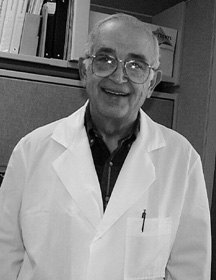
| T H E N I H C A T A L Y S T | M A R C H – A P R I L 1999 |
|
|
|
MORE THAN TWO DECADES OF RESEARCHCULMINATES IN ROTAVIRUS VACCINE |
by Fran Pollner |
 |
|
Al Kapikian
|
It was last summer that the clinical research that Albert Kapikian and colleagues embarked upon in 1974 culminated in a gift package to the world—a licensed live-virus oral vaccine against rotavirus, the most important known cause of severe diarrheal disease, a condition responsible for more years of life lost worldwide than any other, except for lower respiratory tract infections.
Head of the epidemiology section in NIAID’s Laboratory of Infectious Diseases, Kapikian relived his decades-long research "adventure" in a plenary presentation during the NIH Research Festival last October. A month later, he received the 1998 Children’s Vaccine Initiative Pasteur Award for Recent Contributions to Vaccine Development, an honor he shared with two other scientists—Ruth Bishop, who discovered the rotavirus at the Royal Children’s Hospital in Melbourne, Australia, in 1973, and Roger Glass, whose work on rotaviruses began at NIH under Kapikian’s direction and then moved to the Centers for Disease Control and Prevention, where he gathered epidemiological evidence that rotavirus infection is prevalent in developed as well as developing nations.
"It’s the single most important etiologic agent of severe diarrhea in infants and young children—everywhere in the world, including the United States, and everyone has had it by age 5," Kapikian said. "It’s egalitarian; it has no regard for wealth or hygiene." Peak incidence is between 6 and 24 months in the United States and between 3 and 24 months in developing countries. The vaccine is designed to prevent rotavirus-induced severe diarrhea in children under 2—and the estimated 870,000 associated deaths a year, mostly in developing countries, as well as the large number of related hospitalizations and emergency room visits. It’s not designed to protect against infection itself or mild diarrhea. "We’re not concerned about reinfection when a child is older and the infection is less severe, but with that first infection with wild-type rotavirus, which is the severe one," he noted.
Collaborative clinical research with Washington’s Children’s Hospital from 1974 to 1982 established the presence of rotavirus in the stool of 34 percent of children admitted with gastroenteritis. That percentage typically rose to between about 60 and 70 percent in the coolest months, Kapikian recounted. Of 10 human rotavirus serotypes, four have been identified as "epidemiologically important," and it was against these four that vaccine efforts were targeted. "We sought to induce antibodies to the major outer-capsid protein, VP7, and eventually produced a quadrivalent rotavirus vaccine that incorporates VP7 specificity for each of the four epidemiologically significant strains," Kapikian said, summarizing years of his team’s work. He added that "as in Jenner’s 1796 smallpox vaccine, we used a live attenuated agent from a nonhuman host as an immunogen." They used a rhesus rotavirus strain to represent one of the serotypes and later generated rhesus rotavirus-human rotavirus reassortants for each of the other three serotypes to formulate the quadrivalent vaccine.
Between 1984 and 1997, "with tremendous collaboration throughout the U.S. and overseas," thousands of individuals were enrolled in 11 randomized, controlled trials, five of which—three in the United States, one in Finland, and one in Venezuela—were instrumental for FDA approval of the product license for RotaShield, issued to Wyeth-Ayerst, which had entered into a collaborative agreement with NIAID in 1987 (see "NIH Research Yields New Products").
Asked about the cost of
the vaccine, Kapikian said he’d discussed that issue with the company and
that "tiered financing" would be used. "Profits made through
sales in developed countries will be used to fund distribution elsewhere,"
he was assured, he said, noting also that the access issue is a "high priority
of WHO." ![]()